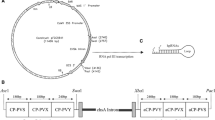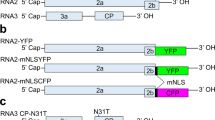Abstract
Induction of R-gene-mediated antiviral resistance results in phenotypically different responses depending on host R gene—virus combinations. The responses include a hypersensitive response (HR), in which virus infection is stopped within the initially infected tissues to form necrotic local lesions (NLLs) by induction of programmed-cell death (PCD), as well as an extreme resistance (ER), in which virus replication is suppressed at the cellular level without PCD induction. A response that causes only tiny NLLs is called a micro-HR, and a response that causes systemic death of the plant by systemic PCD induction is called a systemic HR (SHR). In this study, we used our RCY1—cucumber mosaic virus (CMV) coat protein (CP) system as a model system for R gene—virus recognition and resistance induction, and showed that artificial deletion/alanine substitutions in an arginine-rich motif in CMV CP changed the induced response from an HR to an ER and to intermediate responses between an ER and a micro-HR, where different numbers of tiny NLLs were formed. Using a micro-HR inducing variant, we showed that viral MOI (multiplicity of infection) reduced by 51.5% upon a micro-HR induction, which was much greater than the reduction observed upon an HR induction, providing the first quantitative evidence that a micro-HR is a result of enhanced resistance. Based on the obtained results, we discuss a possible molecular mechanism for the induction of enhanced resistance and the mechanisms for the induction of phenotypically different responses.







Similar content being viewed by others
References
Abebe DA, van Bentum S, Suzuki M, Ando S, Takahashi H, Miyashita S (2021) Plant death caused by inefficient induction of antiviral R-gene-mediated resistance may function as a suicidal population resistance mechanism. Commun Biol 4:947. https://doi.org/10.1038/S42003-021-02482-7
Bendahmane A, Kanyuka K, Baulcombe DC (1999) The Rx gene from potato controls separate virus resistance and cell death responses. Plant Cell 11:781–791. https://doi.org/10.1105/tpc.11.5.781
Collier SM, Moffett P (2009) NB-LRRs work a “bait and switch” on pathogens. Trends Plant Sci 14:521–529. https://doi.org/10.1016/j.tplants.2009.08.001
Cooley MB, Pathirana S, Wu HJ, Kachroo P, Klessig DF (2000) Members of the Arabidopsis HRT/RPP8 family of resistance genes confer resistance to both viral and oomycete pathogens. Plant Cell 12:663–676. https://doi.org/10.1105/tpc.12.5.663
Essuman K, Milbrandt J, Dangl JL, Nishimura MT (2022) Shared TIR enzymatic functions regulate cell death and immunity across the tree of life. Science 377:eabo0001. https://doi.org/10.1126/SCIENCE.ABO0001
Jones RAC, Vincent SJ (2018) Strain-specific hypersensitive and extreme resistance phenotypes elicited by potato virus Y among 39 potato cultivars released in three world regions over a 117-year period. Plant Dis 102:185–196. https://doi.org/10.1094/PDIS-06-17-0901-RE
Kehoe MA, Jones RAC (2016) Improving potato virus Y strain nomenclature: lessons from comparing isolates obtained over a 73-year period. Plant Pathol 65:322–333. https://doi.org/10.1111/PPA.12404
Miyashita S (2018) Studies on replication and evolution mechanisms of plant RNA viruses. J Gen Plant Pathol 84:427–428. https://doi.org/10.1007/s10327-018-0806-3
Miyashita S, Kishino H (2010) Estimation of the size of genetic bottlenecks in cell-to-cell movement of soil-borne wheat mosaic virus and the possible role of the bottlenecks in speeding up selection of variations in trans-acting genes or elements. J Virol 84:1828–1837. https://doi.org/10.1128/JVI.01890-09
Miyashita S, Ishibashi K, Kishino H, Ishikawa M (2015) Viruses roll the dice: the stochastic behavior of viral genome molecules accelerates viral adaptation at the cell and tissue levels. PLoS Biol 13:e1002094. https://doi.org/10.1371/journal.pbio.1002094
R Core Team (2020) R: a language and environment for statistical computing. R Foundation for Statistical Computing, Vienna, Austria. https://www.R-project.org/
Schmitz I, Rao AL (1998) Deletions in the conserved amino-terminal basic arm of cucumber mosaic virus coat protein disrupt virion assembly but do not abolish infectivity and cell-to-cell movement. Virology 248:323–331. https://doi.org/10.1006/viro.1998.9257
Sekine KT, Kawakami S, Hase S, Kubota M, Ichinose Y, Shah J, Kang HG, Klessig DF, Takahashi H (2008) High level expression of a virus resistance gene, RCY1, confers extreme resistance to cucumber mosaic virus in Arabidopsis thaliana. Mol Plant Microbe Interact 21:1398–1407. https://doi.org/10.1094/MPMI-21-11-1398
Smith TJ, Chase E, Schmidt T, Perry KL (2000) The structure of cucumber mosaic virus and comparison to cowpea chlorotic mottle virus. J Virol 74:7578–7586. https://doi.org/10.1128/jvi.74.16.7578-7586.2000
Suzuki M, Kuwata S, Kataoka J, Masuta C, Nitta N, Takanami Y (1991) Functional analysis of deletion mutants of cucumber mosaic virus RNA3 using an in vitro transcription system. Virology 183:106–113. https://doi.org/10.1016/0042-6822(91)90123-S
Takahashi H, Suzuki M, Natsuaki K, Shigyo T, Hino K, Teraoka T, Hosokawa D, Ehara Y (2001) Mapping the virus and host genes involved in the resistance response in cucumber mosaic virus-infected Arabidopsis thaliana. Plant Cell Physiol 42:340–347. https://doi.org/10.1093/pcp/pce039
Takahashi H, Miller J, Nozaki Y, Sukamto TM, Shah J, Hase S, Ikegami M, Ehara Y, Dinesh-Kumar SP (2002) RCY1, an Arabidopsis thaliana RPP8/HRT family resistance gene, conferring resistance to cucumber mosaic virus requires salicylic acid, ethylene and a novel signal transduction mechanism. Plant J 32:655–667. https://doi.org/10.1046/j.1365-313X.2002.01453.x
Takahashi H, Shoji H, Ando S, Kanayama Y, Kusano T, Takeshita M, Suzuki M, Masuta C (2012a) RCY1-mediated resistance to cucumber mosaic virus is regulated by LRR domain-mediated interaction with CMV(Y) following degradation of RCY1. Mol Plant Microbe Interact 25:1171–1185. https://doi.org/10.1094/MPMI-04-12-0076-R
Takahashi H, Kai A, Yamashita M, Ando S, Sekine KT, Kanayama Y, Tomita H (2012b) Cyclic nucleotide-gated ion channel-mediated cell death may not be critical for R gene-conferred resistance to cucumber mosaic virus in Arabidopsis thaliana. Physiol Mol Plant Pathol 79:40–48. https://doi.org/10.1016/j.pmpp.2012.03.003
Zhang HK, Zhang X, Mao BZ, Li Q, He ZH (2004) Alpha-picolinic acid, a fungal toxin and mammal apoptosis-inducing agent, elicits hypersensitive-like response and enhances disease resistance in rice. Cell Res 14:27–33
Acknowledgements
We thank Drs Chikara Masuta, Masashi Suzuki, and Minoru Takeshita for providing the pCY1, pCY2, pCY3, and pC2-A1 constructs.
Funding
This work was partially supported by Japan Society for the Promotion of Science (JSPS) KAKENHI Grants (19H02953, 19K22300, 21K05591, and 22KK0081). The funder has no role in study design, data collection and analysis, decision to publish, or preparation of the manuscript.
Author information
Authors and Affiliations
Contributions
SM designed the study. GK, YS, and SM performed the experiments. GK, DAA, HT and SM analyzed the data. GK and SM prepared the manuscript.
Corresponding author
Ethics declarations
Conflict of interest
The authors declare no conflicts of interest.
Human and animal rights
None of the authors conducted experiments involving human participants or experimental animals.
Additional information
Publisher's Note
Springer Nature remains neutral with regard to jurisdictional claims in published maps and institutional affiliations.
Supplementary Information
Below is the link to the electronic supplementary material.
Rights and permissions
Springer Nature or its licensor (e.g. a society or other partner) holds exclusive rights to this article under a publishing agreement with the author(s) or other rightsholder(s); author self-archiving of the accepted manuscript version of this article is solely governed by the terms of such publishing agreement and applicable law.
About this article
Cite this article
Karino, G., Abebe, D.A., Saijo, Y. et al. Artificial coat protein variants of cucumber mosaic virus induce enhanced resistance upon recognition by an R gene. J Gen Plant Pathol 89, 277–287 (2023). https://doi.org/10.1007/s10327-023-01133-5
Received:
Accepted:
Published:
Issue Date:
DOI: https://doi.org/10.1007/s10327-023-01133-5




